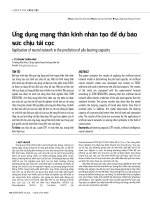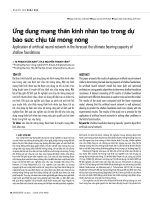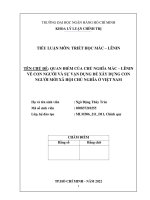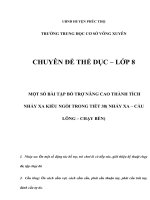ứng dụng mạng thần kinh nhân tạo trong điều khiển tay máy 4 bậc tự do hoạt động từ xa
Bạn đang xem bản rút gọn của tài liệu. Xem và tải ngay bản đầy đủ của tài liệu tại đây (233.48 KB, 6 trang )
TAP CHi KHOA HQC & C 6 N G N G H $ CAC TRU'6NG D^I HQC K V THUAT * S6 86-2012
(
APPLYING NEURAL NETWORK TO CONTROL 4DOF TELE - OPERATION
MANIPULATOR
U'NG DUNG MANG TIMN KINH NHAN TAG TRONG
DIEU KHIEN TAY MAY 4 BAC TV' DO HOAT D O N G TU' XA
Tu Diep Cong Thanh
Ho Chi Minh City University i>f Technology
Received May 16 ,2011
ABSTRACT
Almost all interactive problems between humans and the unsafe environment
such as
dangerous, toxic, infectious or sterile in the world can be solved by robot technology. In particular, one
of feasible and stability solution is Tele-Operation Manipulator Technology By using Ihe master
manipulator to record the movements and behaviour of Ihe driver in a safe environment, then
transmits these parameters over a LAN to the slave manipulator which is controlled in the toxic,
hazardous or sterile environments and strictly comply with people's behaviour is proposed in this
paper
Keywords: Tela-operation, Control, LAN
TOM TAT
Hau het cdc v§n dS tuvng t^c giifa con ngutri va cdc moi tn/ong nguy hiem, dgc hai, lay nhiem
ho$c v6 trung diu di/pc g/d/ guyM bSng ky thu$t robot. Trong dd, mgt trong nhung giai phap mang
tinh kha thi, on dinh va tri/c quan nhit la ky thu$t Tele-Manipulator BSng each su" dung tay may tuxmg
tir de ghi nhan cac chuyen dong va hanh vi cua ngutri diSu khiSn trong moi tnjong an toan, sau do
truyen cac thong so ndy qua mang LAN cho tay may chinh thuc hi$n dung theo hanh vi cua nguui
didu khidn trong moi truing ddc h^i va nguy hiSm ho$c vd trung la huung nghien cuu dd xuit tmng
bai bao nay.
TLT khoa: Hoat dong tu- xa, Dieu khien, Mang LAN.
L INTRODUCTION
Tele-Operation Manipulator (TM) system
is a remote control manipulator consists of two
arms: the master and slave. Slave manipulator
is controlled to perform the same motion as
master manipulator. To implement this control,
master manipulator is controlled by human. The
desired motion of the master manipulator is
recognized by sensors and these values is
transmitted via LAN lo the slave manipulator
controller.
In 1898, Nikola Tesia made boat control
model using radio in New York first to now, the
TM has a history of development over a century
[1]. TM system as the first true master - slave is
made a pure mechanical structure is benevolent
R. Goertz late in 1940 at the National
Laboratory Argone [2]. In 1954, R. Goertz
system development operations with the first
electro-mechanical servo controller. With the
development of more modem techniques, the
TM system appear in many areas more efficient
service lo people such as explosives detection
arm of national defense and arm on the
spacecraft, hand-picking machine of nuclear
fuel in nuclear power indushy. and especially
the type of ann surgery in remote health.
One of the outstanding research of robots
for medical applications is manipulator system
tor remote microsurgery institute KAIST,
Korea [3] and surgical manipulator system
accuracy in medicine at the University of
Washington, USA [4]
TM control to execute as well as the
ability to monitor and respond in real time, a
number of studies related to model algorithms
and system control are presented, such as
adaptive control using a slide control algorithm
is presented by Plato [5], techniques to reduce
transmission time over the network in conttol
TM suggested by Lee [6], Sano technical
proposal in the time delay compensation control
T ^ P CHi KHOA HQC & CONG NGHE CAC T R U 6 N G BAI HQC KY THUAT * S 6 86 - 2012
TM [7], with Towhidkhah modeling and
predictive control [8], and robust control with
random time delay proposed by Prokopiou [9],
etc..
In this study, a tow cost TM system is
presented. A newly proposed neural network
controller is applied to control four degrees of
freedom (4D0F) manipulator via LAN. Results
obtained will be presented through experiment.
receives the responese of 4DOF TM. To control
slave manipulator, PC server will compute the
control signals and send these signals to low
cost circuit using PIC 18F4450 through PC
client via LAN. Control software is coded
based on C#, and the phoptograph of
experinental system is shown in figure 3.
II. EXPERIMENTAL SETUP
The overview of system and schematic
diagram of system are presented in figure I and
figure 2 respectively.
Fig 3. Photograph of
apparatus
.CA
.-
1^, ^s.,
Fig I. Overview of the proposed TM system
the experimental
HI. CONTROL SYSTEM
The overall of control system is shown in
figure 4. To improve control performance,
neural network controller is proposed. The
structure of the newly proposed control
algorithm using neural network is shown in
figure 5.
The input layer has three neurons. There
are six neurons in hidden layer. All layers are
connected in only the forward direction. Wellknown steepest descent learning method is
applied for online adaptive control. The input to
each neuron is given as the weighted sum of
outputs fi-om the previous layer. The output of
each neuron is generated by linear function in
the input layer. In hidden and output layers, the
sigmoid function is used. And the structure of
neural network is shown in figure. 6.
Fig 2. Schematic diagram of system
The system includes master manipulator
is controlled by human and enforce slave
manipulator motion the same with the master
manipulator motion. Parameters of motion of
the master manipulator are recognized by the
encoders (USDigital S5 Optical 1024R/P) and
sent to PC server (computer 2.4 Ghz Pentum
IV) through PCI 1874 circuit. PC server
transmits these informations to the PC client via
LAN (computer Pentum IV 2.4 Ghz) as well as
/.—(-^) =
(1)
To construct learning rule, the following
symbols are defined:
/ ' : Input to the jth neuron in the input layer
o' :Output from the jth neuron in the input layer
/" : Input to the kth neuron in the hidden layer
of :Output of the kth neuron in the hidden layer
/^: Input to the output layer
TAP CHi KHOA HQC & C 6 N G NGHJ: CAC T R U I N G D^l HQC K t THU^T * S 6 86 - 2012
" : Output from the output layer
The operation of each neuron is described as:
cOji, : Weight from the jlh neuron in the input
";='•;
(2)
layer to the kth neuron in the hidden layer
Q)"": Weight fi-om the kih neuron in Ihe hidden
layer to the output layer
"/'=./.„. ,0i']. / i ' = K o j
/
o" = A,, ,{i"l
(3)
/'•'=X'""V
<4)
The leaning process is based on the back
propagation algorithm, which minimizes E
given by:
E = -{Setpo\n\-Output)'
PIC Ma (Mr wwuet)
=-e-
(5)
The weights are updated by the following
increments to minimize E:
BE
BE
A <
iv« nr4i3
where rj>0\s learning rate lo determine
naizii
2~:
the speed of leaning. — ~
in Eq. (6) can be
calculated by:
dE ^ dE di^
Fig 4. The overall of control system
'j
Neuron Network ã -
'ã'-
^r^^lKVho."
(8)
= -ô" ^^
(9)
di
Fig 5. Structure of tfte proposed controller
*f
-
/_
,
.
'
(7)
dro^" ~ di''da?:'"
-S''>,o»
dcol'"
^ 'S a generalized error calculated by:
.Q _
~
dE dy do°
dy do" dl"
(10)
'B'-f}
do"
a,"
a/.,i....,.('°)
di"
(II)
/sigmoun'
)
(12)
As done by Yamada and Yabuta [10], for
Fig 6. The structure of neural network
convenience, — ^ is assumed to be constantdo"
T^P CHi KHOA HQC & CONG NGHE CAC TRU'OWG D,^l HQC KV THUAT * S6 86 - 2012
dy
•• C =
(13)
const
The increment of weight can be written
as:
A a , r = - n - ^ = n-S''>^oi'
(14)
dCOi.
Consequently, the weight is updated by:
<''=<°+,,x„Cx4,„„„(/'')xo,"
(15)
The update equation, the weight 0)''^' can
be derived in the same manner.
<=<+7x5/'>=°;
S"
dE cy CO tl
cy co
Cl
ro,
(16)
co^
ct^
(17)
e X C X f:,„.,„ (i° ) X <0r X 4 . W ('." )
And the control signal is given by:
u^=K„o''
(18)
K.„: Proportional gain of the output of neural
network controller. The effectiveness of the
proposed controller will be demonstrated
through experiment.
IV. EXPERIMENTAL RESULTS
At first, proposed controller is applied for
control the motion of slave manipulator. The
control parametters of proposed controller are
chosen through trial and error. The learning
parameter of neural network controller is given
through trial and error and equal 0.001. The
initial starts of the weights of neural network
are random within ranger -0.1 to 0.1. And the
proportional gain of the output of neural
network controller is 150. The experimental
result of step response of TM are shown in
figure 7. From figure 7, it shows that responses
of system is stable. In addition, with fast
changes of joint angles, and performances with
good tracking are also obtained.
In order to improvement control
performance of system, sinusoidal form and
triangle form are tested, and the experimental
result is shown in figure 8 and figure 9
respectively. From experimental results, it is
shown that the response of system with respect
to proposed controller is stable and good.
— Response
Reference
<
80
60
40
1^
-
^r
'--
120 -,
100 -
eo .
<
c
40 .
20 0 -
1
:f^ s
,
100 80 -
1
^
100 -
\
60 40 .
0
-
J
l._
U
20 -
<
,
pJ
J '- ;
rj"
\jwmm
^\NWmN\
^^^,jwmiw^A
jjmym\
20
Fig 7. Step response of proposed controller
30
40
so
60
Fig 8. Sine response of proposed controller
T ^ P CHi KHOA HQC & C 6 N G NGHf CAC TRU'dNGD^I HQC KVTHUi^T * S 6 86-2012
— Response
Reference
- Response
Reference
"
80
60
If
\
•''
.
^
.
V
.
5 ft
^1
J\ A'-
.
.
40
.
20
•
0
•
/'
.
120 .
100 •
eo eo .
40 .
20 -
eo
-
20
-
eo
-
,
H J!
•
^1
.1
'
: A
'
eo
^<
Fig 9. Triangle response of proposed controller
Finally, doing practice with movement of
master manipulator and checking performance
of salve manipulator Fxr"-''":r',..l I'C^MU •>
shown in figure 10. And it is no doubt that the
TM system works well and the proposed
algorithms are fine. The responses of slave
manipulator are almost tracking with the
reference input which is given from the motion
of master manipulator.
V. CONCLUSIONS
In this paper, a low cost tele-operation
manipulator system as well as an intelligent
control using neural network are proposed . It is
40
.
20
-
0
-
r
n
fi
J"
.
..--'''
v^
-
• ; -
Fig 10. Real response of TM system
shown that the proposed control methods had a
good
performance
for
tele-operation
rmnimilator. It can be leen from exnerimental
results that these controllers had an adaptive
control capability and strong robustness. The
controllers designed by this method do not need
any training procedure in advance, but they use
only the inputs and outputs of the plant for the
adaptation of coiiir^'I parameters and can tune
the parameters iieratively.
Here, it can be seen that the neural
network controller is the most suitable
-controlling strategy to develop TM.
REFERENCES
1. N. Tesla. "Method of and Apparatus for Controlling Mechanism of Moving Vessels or Vehicles"
(1898)
2. Raymond Goertz and R. Thompson. "Electronically Controlled Manipulator" Nucleonics, (1954).
3. Dong-Soo Kwon Ki Young Woo Se Kyong Song Wan Soo Kim Hyung Suck Cho. "Microsugical
Telerobot system" In Intelligent Robots and Systems. Int. Conf, Oct., (1998).
4. Blake H., Diana F., Hawkeye K., Mitch L., Jacob R., Ganesh S., "Evaluation of RAVEN Surgical
Telerobot during the NASA Extreme Environment Mission Operations 12 Mission", Report of
University of Washington, (2009).
5. Platon A. P., Spyros G. T., William S. H., "A Novel Scheme for Human-Friendly and Time-Delays
T ^ P CHi KHOA HQC & CONG NGH g CAC TRUING D»l HQC KV" THli^T * S686-2012
Robust Neuropredictive Teleoperation", Jour, of Intelligent and Robotic Systems, Vol.25, No.4,
pp.311-340,(1999)
6. Lee, S. and Lee, H. S.: Modeling, design and evaluation of advanced teleoperator control systems
with short time delay, IEEE Trans. Robotics Automat. Vol.9, pp. 607-623, (1993)
7. Sano, A., Fujimoto, H., and Tanaka, M.: "Gain-scheduled compensation for time delay of bilateral
teleoperation", IEEE Internal. Conf on Robot, Automat, pp. 1916-1923, (1998)
8. Towhidkhah, F., Gander, R. E.. and Wood, H. C "Model predictive control: A model for joint
movement", J. Motor Behavior, Vol 29, No 3 pp., 209-222, (1997)
9. Prokopiou, P. A., Harwin. W. S., and Tzafestas, S. G.: "Variable-time-delays-robust
telemanipulation through master state prediction," lEEE/ASME Internal. Conf on Advan. Intel.
Mechatronics, pp.19-22, (1999).
10.Yamada T, Yabuta T., "Neural network controller using auto-tuning method for nonlinear
ftinctions," IEEE Trans Neural Networks; 595-601,(1992)
Author's address: Tu Diep Cong Thanh - Tel: 84-838655348 - Email: tdcthanh^hcmul.cdu.vn
Faculty of Mechanical Engineering
Ho Chi Minh City University of Technology
268 Ly Thuong Kiel Sir., Disl. 10, Ho Chi Minh City, VietNam




